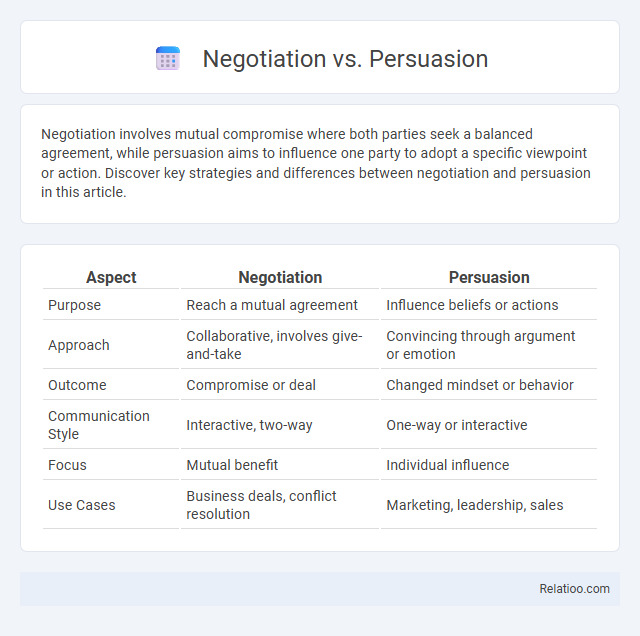Negotiation involves mutual compromise where both parties seek a balanced agreement, while persuasion aims to influence one party to adopt a specific viewpoint or action. Discover key strategies and differences between negotiation and persuasion in this article.
Table of Comparison
| Aspect | Negotiation | Persuasion |
|---|---|---|
| Purpose | Reach a mutual agreement | Influence beliefs or actions |
| Approach | Collaborative, involves give-and-take | Convincing through argument or emotion |
| Outcome | Compromise or deal | Changed mindset or behavior |
| Communication Style | Interactive, two-way | One-way or interactive |
| Focus | Mutual benefit | Individual influence |
| Use Cases | Business deals, conflict resolution | Marketing, leadership, sales |
Introduction to Negotiation and Persuasion
Negotiation involves a strategic dialogue between two or more parties aiming to reach a mutually beneficial agreement, often focusing on compromise and conflict resolution. Persuasion centers on influencing others' attitudes or behaviors through reasoning and emotional appeal, typically without direct negotiation or concessions. Understanding the distinctions is crucial for effectively applying communication techniques in business, law, and diplomacy.
Defining Negotiation
Negotiation is a structured dialogue between two or more parties aimed at reaching a mutually beneficial agreement by addressing differing interests and finding common ground. Unlike persuasion, which involves influencing attitudes or beliefs to change behavior, negotiation emphasizes collaborative problem-solving and compromise. Effective negotiation requires clear communication, active listening, and strategic concessions to achieve outcomes acceptable to all involved stakeholders.
Defining Persuasion
Persuasion is the art of influencing someone's beliefs, attitudes, or behaviors through logical reasoning, emotional appeal, or credibility to achieve a desired outcome without direct compromise. Unlike negotiation, which involves exchanging offers to reach a mutual agreement, persuasion aims to align your audience's viewpoint with your own without necessarily requiring concessions. Your success in persuasion depends on effectively communicating benefits and addressing concerns to motivate voluntary acceptance.
Key Differences Between Negotiation and Persuasion
Negotiation involves a structured process where two or more parties exchange offers and counteroffers to reach a mutually acceptable agreement, emphasizing compromise and collaboration. Persuasion focuses on influencing another party's attitudes, beliefs, or behavior through logical arguments, emotional appeal, or credibility, often aiming for one-sided acceptance without immediate reciprocation. Key differences include negotiation's goal of a balanced agreement versus persuasion's intent to sway decision-making unilaterally, and negotiation's reliance on dialogue and concessions contrasting with persuasion's emphasis on communication techniques and psychological influence.
Core Skills Required for Negotiation
Effective negotiation demands core skills such as active listening, emotional intelligence, and strategic problem-solving to reach mutually beneficial agreements. Mastery of communication techniques and the ability to manage conflicts are essential for creating value and maintaining relationships during negotiations. Unlike persuasion, which focuses on influencing others' beliefs or behaviors, negotiation centers on collaboration and compromise to achieve shared goals.
Essential Skills for Effective Persuasion
Effective persuasion hinges on mastering essential skills such as active listening, emotional intelligence, and the ability to present logical arguments tailored to the audience's values and needs. Unlike negotiation, which involves a back-and-forth exchange to reach mutual agreement, persuasion aims to influence decisions by appealing to credibility and trust. Skillful use of storytelling and clear communication enhances persuasive impact, making these skills crucial for leaders, marketers, and negotiators alike.
When to Use Negotiation vs. Persuasion
Negotiation is best used when both parties seek a mutually beneficial agreement involving compromises, typically in business deals, contracts, or conflict resolution. Persuasion is ideal when one party aims to influence another's beliefs, attitudes, or behaviors without requiring immediate concessions, often in marketing or leadership contexts. Understanding the context and desired outcomes helps determine whether to engage in negotiation for collaborative problem-solving or persuasion for shaping opinions and motivating action.
Real-World Examples: Negotiation vs. Persuasion
Negotiation involves a two-way dialogue where both parties aim to reach a mutually beneficial agreement, such as a business deal where buyers and sellers agree on price and terms. Persuasion focuses on influencing someone's beliefs or actions through logical arguments or emotional appeal, like a marketer convincing consumers to choose a specific brand. Your ability to distinguish between negotiation and persuasion can determine success in scenarios ranging from salary discussions to marketing strategies.
Common Challenges and Solutions
Negotiation, persuasion, and mediation each face common challenges such as communication barriers, emotional biases, and conflicting interests that can hinder achieving agreements. Solutions involve fostering active listening, building trust through empathy, and seeking mutually beneficial outcomes to address these obstacles effectively. You can improve your outcomes by adapting strategies tailored to the specific dynamics of negotiation, persuasion, or mediation contexts.
Conclusion: Choosing the Right Approach
Choosing the right approach between negotiation, persuasion, and compromise depends on the context and your desired outcome. Negotiation emphasizes mutual agreement and problem-solving through dialogue, while persuasion focuses on influencing beliefs or actions without necessarily requiring agreement. Your success hinges on understanding when to collaborate for a win-win solution, when to influence decisively, and when to find middle ground that benefits all parties.

Infographic: Negotiation vs Persuasion
 relatioo.com
relatioo.com